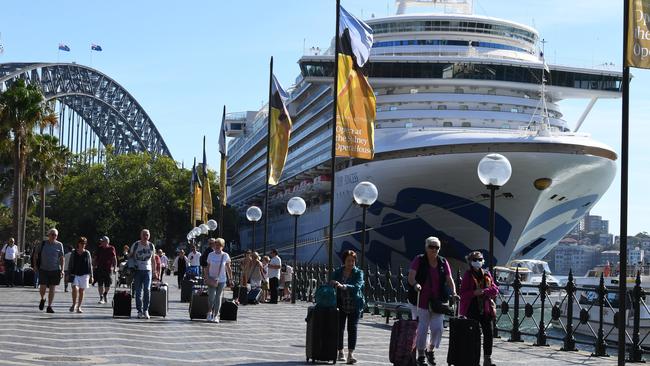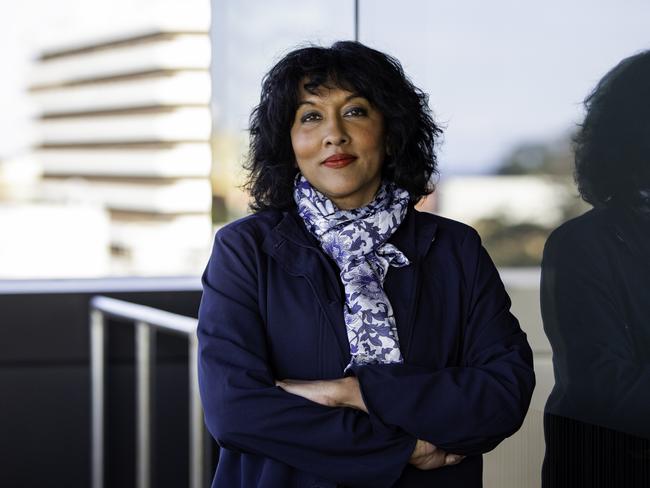Coronavirus detectives on the case
These health workers are not dressed in scrubs or surgical masks, but they are just as much a part of the frontline fight against COVID-19.

In a nondescript office building on Sydney’s lower north shore, a small army of health workers toils late into the night to curb the relentless spread of COVID-19.
Its members are not dressed in scrubs, surgical masks or bright latex gloves like so many of their colleagues. But they are just as much a part of the frontline fight against the coronavirus pandemic as the nurses, doctors and specialists manning emergency rooms and intensive care units around Australia.
All over the country, coronavirus trace teams are surging their workforces to keep pace with the ballooning number of new infections.
Part detective, part clinician, part social worker, they operate in shifts throughout the day mapping the spread of COVID-19 by identifying and isolating anyone who has come into close contact with the disease.
They track down cruise ship passengers, conference attendees or international travellers unlucky enough to share a plane with someone who, five days after his flight, wakes up with the aching throat and soaring temperature that are the hallmarks of COVID-19.
Their aim is to beat back a virus with a rate of infection that is doubling every three days and which, if not contained, will crash the public health system, sending an untold number of Australians into the nation’s intensive care wards and on to an early grave.
But as the pace of infection skyrockets, authorities are now looking at new, more intrusive methods to track the virus.
NSW Health has confirmed it is investigating an array of technologies, including GPS tracking, to keep pace with the rapid spread of infection.
Such technologies are already in use in countries such as Singapore and Hong Kong, where authorities mine GPS data harvested from smartphones to track the movements of infected citizens.
For a country such as Australia, where citizens place a high premium on their privacy, such measures seem unthinkable. But as the pandemic transforms life as we know it, unthinkable is no longer a meaningful term. Increasingly, experts are warning that such measures are not only necessary but also inevitable.
“In Australia we are very cognisant of privacy so we are slow to use GPS tracking,” Marylouise McLaws, a member of the World Health Organisation’s expert advisory panel, told The Weekend Australian. “But I think in these extraordinary times GPS tracking should be utilised to its fullest possible extent.”
For now, coronavirus testing is done manually, through focused interviews and back-tracing of COVID-19 cases. At the time of writing there were 3166 confirmed cases in Australia, a threefold increase on last week.
The steep escalation in numbers is placing huge strain on trace workers, who must work quickly to identify new cases and ring-fence those who have been in close contact.
Clinicians, part-time doctors, even the Australian Defence Force have been called in to help map the spread of the disease.
They work in two long shifts throughout the day.
They start early and finish late at night, when the emails, phone calls and text messages they send to suspected contacts are likely to go unanswered.
NSW Health won’t discuss numbers but The Weekend Australian understands the size of the contact tracing team is about 50, a fraction of what it will climb to as new skeins of infection trace their way through the community. That is in addition to the hundreds of public health workers employed in NSW’s local health districts, and whose job is to run down suspected cases of COVID-19.
The result is a two-tiered system, with local public health workers running a huge dragnet over possible infections, then passing along confirmed cases to the trace team.
For example, if a visiting speaker at a conference held in Bankstown tests positive after they have returned home, it will fall to public health workers in the South Western Sydney Local Health District to identify anyone at the conference who may have had close contact with the speaker.
These workers, all of whom are trained clinicians, will use passenger arrival cards, tips from friends or other attendees, or hotel reservation records to run down a list of names. If any of those names test positive, the case will be escalated to the NSW contact tracing team, which will conduct a more focused investigation.
Craig Dalton, an associate professor at the University of Newcastle’s school of public health, says the current approach is to interview every confirmed new COVID-19 case about their network of recent contacts.
People who test positive will receive a phone call from a trace worker as soon as their test result comes back.
“The first thing they’ll ask you is when your onset illness happened,’’ Dalton told The Weekend Australian. “Then they’ll go back 24 hours ahead of that.
“What we’re particularly looking for is household contacts because that’s where the biggest risk is. Then we look at people you’ve had 15 minutes of face-to-face contact with or two hours or more in the same room.’’
Dalton says in the case of people infected on cruise ships, tracing contacts is relatively easy. The teams will rely on passenger cards, arrival cards at airports or flight manifests. Older people, too, are generally simple to trace. However, a younger patient might yield 10 or 15 names, all of whom will need to be contacted.
One of the first questions a trace worker will ask a patient is if they agree to being identified as a potential source of infection.
In most cases, the answer is yes. This makes the job of tracking a person’s movements easier. But if they don’t, the trace worker will phone those in close contact with a patient and tell them simply they have come into contact with a known case of coronavirus.
One of the things trace workers are trying to do is align the movements of the patient with their nominated contacts.
While some people try to conceal or downplay their exposure to others, the bigger problem is the fallibility of human memory and the fuzzy nature of disease.
Patients sometimes find it difficult to say exactly when the illness took hold. Dalton says trace worker will use “anchors” to pinpoint the onset of the virus. Did you miss a day of work? Can a dinner party because of a sore throat? Skip the gym because you were feeling flat?
This process is crucial. Experts believe COVID-19 may be infectious for up to 24 hours before symptoms manifest, if they manifest at all.
“We might ask them to go through their Google maps timeline and ask them to jog their memory,” Dalton says. “We might ask them to look at their calendar.
“If we’re trying to tie down the date of illness, we might ask them what they’ve missed.”
The first question a tracer will ask is: do you feel sick? If the answer is yes, you’ll be directed to take a test. So far NSW Health has conducted more than 77,000 tests, a number that is climbing rapidly.
Patients are given a throat swab and a nasal swab. The last one is the worst. A long, thin swab is threaded through a patient’s head to the very back of the nasal passage. It is not painful, just incredibly uncomfortable.
Raina MacIntyre is a doctor and epidemiologist at the University of NSW. She sat on the government’s ad hoc committee set up to advise on the coronavirus response.
She says that as effective as our tracing teams may or may not be, their capacity to effectively carry out contact tracing is shrinking in inverse proportion to the exponential spread of the disease.
“The worst thing we can do is give up on contact tracing,” MacIntyre told The Weekend Australian. “There’s only four things we can do — (first,) identify as many cases as we can. The second thing is contact tracing and symptom monitoring. Then there is social distancing and travel bans. The only thing were doing well at the moment is social distancing and travel bans.’’

MacIntyre points to Singapore, where authorities harvest GPS data from smartphones to identify anyone who has been in proximity to a confirmed case of COVID-19 for more than 30 minutes.
The data is processed in an app called TraceTogether, which sends out an alert to at-risk citizens.
The country’s health minister says it can trace up to 4000 contacts a day, giving authorities a long reach into a country of just more than 5.5 million people.
NSW Council for Civil Liberties spokesman Stephen Blanks says any extraordinary powers used by health officials to curb the contagion must be subject to “clear, short sunset clauses”.
“These tracking powers have been effective in other countries,” Blanks told The Weekend Australian. “This is an extreme situation.
“I think it’s appropriate for this data to be used, provided it’s used only for this purpose and subject to strict oversight.”
MacIntyre says Australia must look to Asian countries that have been at the forefront of the fight against COVID-19, and before that severe acute respiratory syndrome. South Korea, Singapore and Hong Kong have all leveraged technology — in some cases to a frightening degree — to control infection and enforce self-isolation. In Hong Kong, returning travellers are issued electronic wristbands at the airport. A QR code embedded in the bracelet pairs with a smartphone app. The idea is to enforce the mandatory 14-day self-isolation period for anyone entering the city.
But while Hong Kongers appear to have accepted the need for such measures, the technology itself has been blighted by failure. Thousands of bands have yet to be activated, not everyone has a smartphone and enforcement has reportedly been patchy.
Dalton says such measures may have a place provided they are used in parallel with existing analog methods, not in place of them. “There’s a human factor in that,” he says. “People get to ask questions or raise concerns.”




To join the conversation, please log in. Don't have an account? Register
Join the conversation, you are commenting as Logout